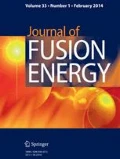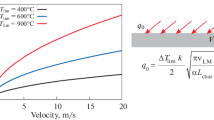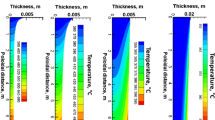Abstract
The APEX study is investigating the use of free flowing liquid surfaces to form the inner surface of the chamber around a fusion plasma. In this study the modeling of APEX hybrid reactor produced by using ARIES-RS hybrid reactor technology, was performed by using the Monte Carlo code and ENF/B–V–VI nuclear data. The most important feature of APEX hybrid reactor is that the first wall surrounding the plasma is liquid. The advantages of utilizing a liquid wall are high power density capacity, good power transformation productivity the magnitude of the reactor’s operational duration, low failure percentage, short maintenance time and the inclusion of the system’s simple technology and material. Around the fusion chamber, molten salt Li2BeF4 and natural lithium were used as cooling materials. The result of the study indicated that fissile material production UF4 and ThF4 heavy metal salt increased nearly at the same percentage.







Similar content being viewed by others
Abbreviations
- T6 :
-
Tritium breeding rate obtained from reaction 6Li(n,α)T
- T7 :
-
Tritium breeding rate obtained from Reaction 7Li(n,α,n’)T
- TBR: T6 + T7 :
-
Tritium breeding ratio
- GMD:
-
Gravity momentum driver
- COE:
-
Cost of electricity
- V:
-
Fluid velocity (m/s)
- g:
-
Gravitational acceleration (m/s2)
- Rc :
-
Radius of curvature (m)
- MHD:
-
Magneto hydrodynamic
- M:
-
The energy multiplication factor
References
A. Hançerlioğullari, Determining of energy multiplication in the APEX hybrid reactor by using ThF4 and UF4 heavy metal salts. Int. J. Energ Res. (2011). doi:10.1001/er.1919
S. Şahin, M. Übeyli, Modified APEX reactor as a fusion breeder. Energ. Convers. Manag. Elsevier, 45, 1497–1512 (2004)
M.A. Abdou,The APEX team, exploring novel high power density concepts for attractive fusion systems. Fusion Eng. Des. 45, 67–145 (1999)
M.A. Abdou, A. Ying et al., The APEX team. On the exploration of innovative concepts for fusion chamber technology. Fusion Eng. Des. 54, 181–247 (2001)
R.E. Rognlien, T.D. Rensink, M.E. Smolentsev, S.S. M.Z. Youssef, A. Sawan et al., Fusion reactor design with a liquid first wall and divertor. Fusion Eng. Des. 72, 181–221 (2004)
M.Z. Youssef, N. Morley, A. El-Azabet, X-rays surface and volumetric heat deposition and tritium breeding issues in liquid-protected FW in high power density devices. Paper presented at the 13th topical meeting on the technology of fusion power. Nashville, Tennessee, June 7–11 (1998)
M.A. Abdou, Preface Fusion Eng. Des. 72, 1–2 (2004)
J. Bremister, MCNP-4A general Monte Carlo code N-particle transport code, Version 4A, La-12625, November (1993)
R.W. Moir, Liquid first walls for a magnetic fusion energy configurations. Nucl. Fusion 37, 557 (1997)”
M.A. Abdou, Fusion Eng. Des. 45, 145–167 (1999)
M.A. Abdou, A. Ying, N. Morle, Fusion Eng. Des. 54,181–247 (2001)
S. Şahin, M. Übeyli, Energ. Convers. Manag. 45, 1497–1512 (2004)
M. Übeyli, J. Fusion Energ. 26(4), 317–321 (2007)
X.P. Lio, T.Y. Tong, FDS group, Development and application of Mcnp auto-modeling tool: Mcam 3.0. Fusion Eng. Des. 75–79, 1275–1279 (2005)
B. Şarer, M. Günay, M.E. Korkmaz, A. Hançerlioğulları, Fusion Sci. Technol. 52(1), 107–115 (2007)
K.A. McCarty, D.A. Petti, R.L. Moore, B.J. Merrill, Safety issues associated with mobilized activation products in selected APEX designs. Fusion Eng. Des. 51–52, 549–554 (2000)
M.Z. Youssef, M.E. Sawan, D.-K. Sze, The breeding potential of "Flinabe" and comparison to "Flibe" in "Cliff" high power density concept. Paper presented at the 6th international symposium on fusion nuclear technology, San Diego, California, 2001
Author information
Authors and Affiliations
Corresponding author
Rights and permissions
About this article
Cite this article
Hançerlioğullari, A., Cini, M. Different Mechanisms for Establishing Liquid Walls in Advanced Reactor Systems. J Fusion Energ 32, 155–163 (2013). https://doi.org/10.1007/s10894-012-9539-z
Published:
Issue Date:
DOI: https://doi.org/10.1007/s10894-012-9539-z




